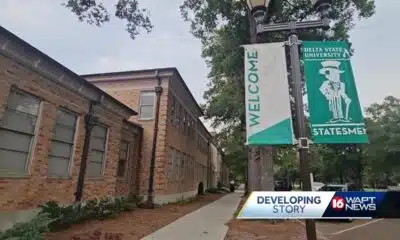Mississippi Today
Mississippi University for Women is betting its future on a new name. Will it work?
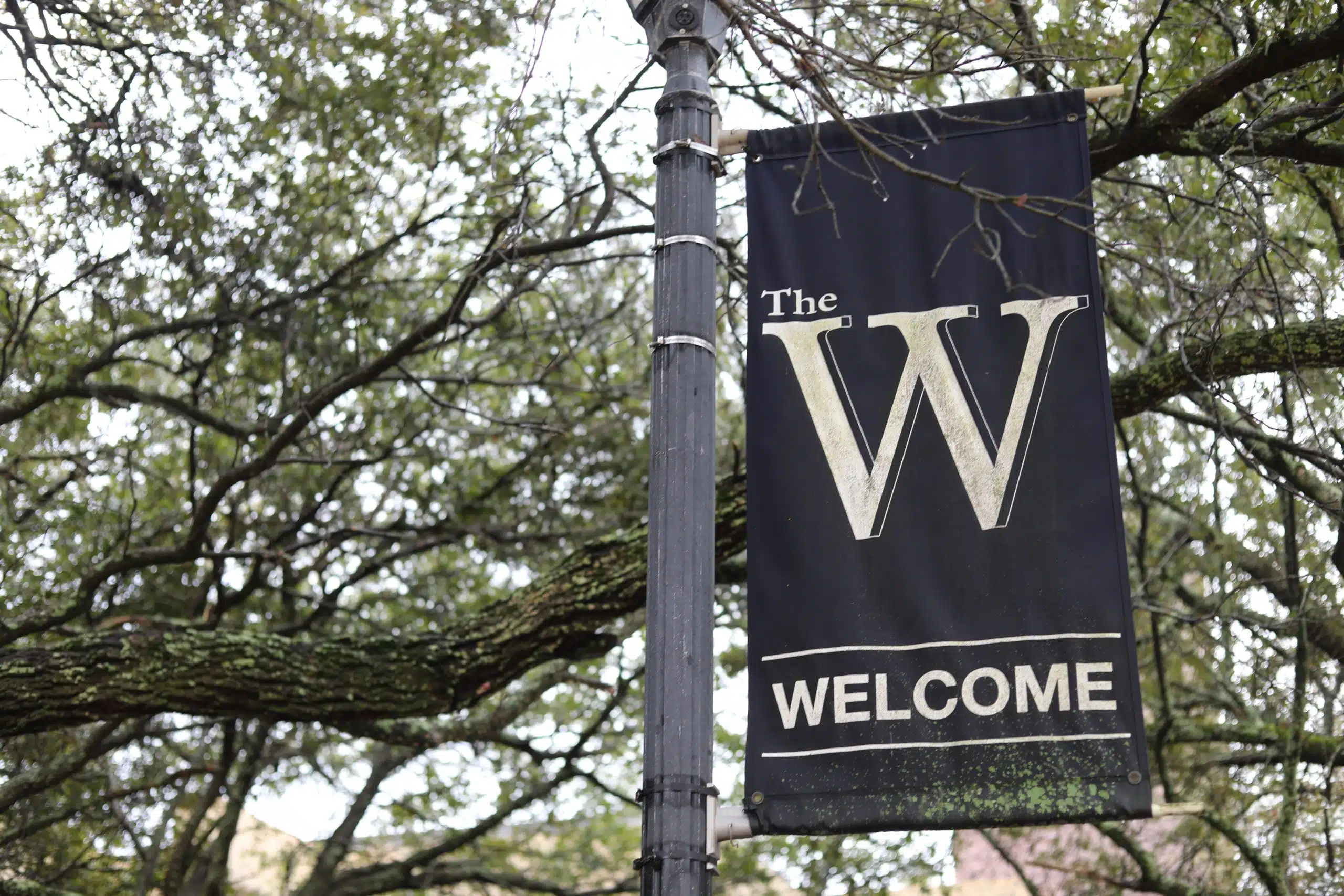
COLUMBUS — Nora Miller, the president of Mississippi University for Women, opened a letter from her deans in 2022 that warned the country’s first state-supported women’s college had reached a critical crossroads.
Without bold change, the deans wrote, the pool of prospective students was “likely to grow dangerously thin,” affecting tuition. Their recommendation: Change the name to one that includes all students, not just women. After all, the university had been co-ed since 1982.
One consulting firm, three listening sessions, 4,300 survey responses, one failed proposal, and one apology later, MUW will ask lawmakers to approve a new name next month. But as the institution seeks to reposition itself to meet an uncertain moment for higher education in Mississippi, it has faced criticism from some alumni, passionate about the past, who have questioned if a new name is needed at all.
Lost in the hullabaloo is the fact MUW faces much bigger issues than its name, according to more than a dozen interviews Mississippi Today conducted with students, faculty, administrators and alumni.
Enrollment has continued to fall since the dean’s letter. All told, the campus has shrunk to just 2,227 students from its peak of more than 3,100 in the late 1990s. The tuition-dependent university has been operating at a deficit, losing $18 million in fiscal year 2022. And it likely can’t turn to the state for help: Mississippi’s state funding for higher education has barely recovered from the Great Recession of 2008. The liberal arts education that MUW offers is increasingly pooh-poohed by lawmakers and other state officials who view workforce development as “the message of the day.”
To be sure, all of Mississippi’s regional colleges are struggling, so MUW’s plight isn’t totally unique. But within thirty miles of its doorstep, MUW is facing a hydra — a behemoth SEC school, a booming industrial park and a flourishing community college — all while dealing with a name that excludes roughly half of the students it wants to admit.
“It’s kind of like false advertising, isn’t it?” said Dee Anne Larson, a marketing professor on the university’s naming committee.
The university has acknowledged it needs to do a better job of selling what it offers: Comparatively affordable tuition, small class sizes and a familial campus. It has revamped its recruitment strategies, brought back athletics and pumped money into professional programs like culinary arts, speech language pathology and nursing.
“While we would prefer not running at a deficit,” Miller said, “sometimes you have to invest in things.”
Signs of that investment, though, are hard to spot. North on Highway 25, a brick sign for Starkville brags of being the “home of Mississippi State University.” Over the Lowndes County line, at the Golden Triangle Global Industrial Aerospace Park, is East Mississippi Community College’s glassy “communiversity” and its LED marquee.
The sign for Columbus, called the “friendly city,” makes no mention of MUW. The university employs hundreds of people in the region, a fact belied by its quiet presence.
Miller acknowledged workforce development programs entice high school graduates. But, she said, when younger workers from Steel Dynamics get tired, they’ll start looking for a pathway to office jobs.
“And I think some of those steelworkers aren’t gonna take advantage of that” at MUW, Miller said, “because ‘Mississippi University for Women’ will be on their degree.”
Cutting ties with the long blue line?
When MUW sent Miller an offer letter in 1979, she thought it was for a “finishing school” and threw it in the trash. Her mom convinced Miller, a National Merit Scholarship semifinalist, to take a second look.
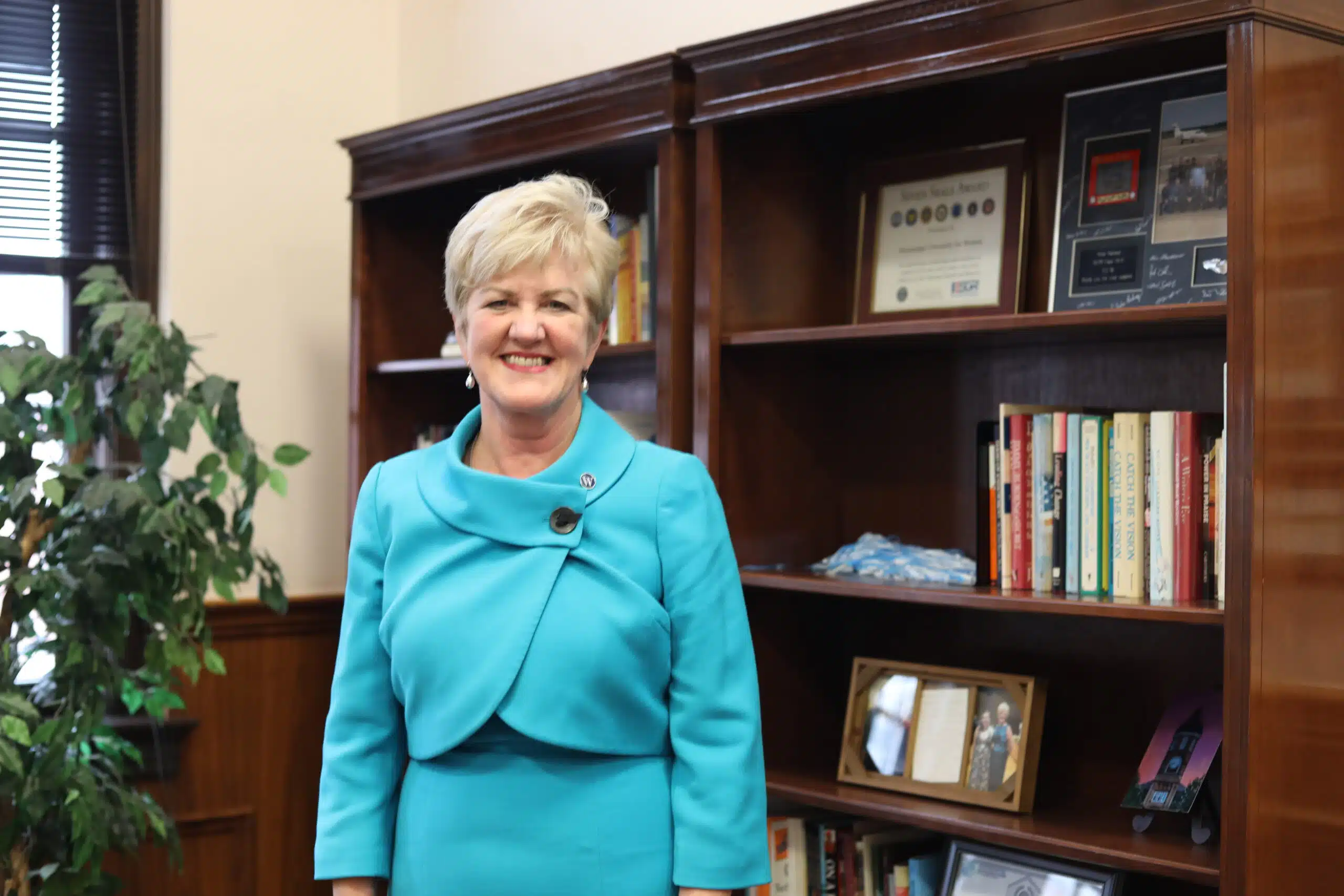
Three years later, when the Institutions of Higher Learning Board of Trustees ordered MUW to admit men following a U.S. Supreme Court ruling on the university’s admissions policy, Miller’s first thought was “at least we get to keep the name.”
Then state-supported women’s colleges across the country started taking “women” out of their names. MUW didn’t in large part because the university’s leadership failed to get alumni on board. Even though the university has changed its name four times throughout its history — it was originally the Industrial Institute and College for the Education of White Girls — the alumni just couldn’t let go of “The W.”
Many still can’t.
Earlier this month, the university’s first proposal, Mississippi Brightwell University, flopped. The feedback was resoundingly negative.
That’s when an unofficial group of alumni started discussing an alternate proposal: “The W: A Mississippi University.” It seemed to capture the campus’s Ivy League aspirations, said Laura Tubb Prestwick, who graduated in 2008, works in brand-name strategy and was part of the unofficial group.
There’s an emotional stake in changing the name for “W girls” like Prestwick, whose grandmother also attended. Prestwick grew up going to modeling, photography and musical theater camps at MUW, and reading old copies of the “Meh Lady” yearbooks.
“When Tropicana changed their packaging, they saw a 20% drop in sales,” Prestwick said. “That’s an emotional tie to orange juice. Can you fathom it being somewhere you took out student loans for?”
Facing the demographic cliff
But MUW can’t sustain itself solely off the pockets of legacy students like Prestwick.
In Mississippi, as in nearly every state in the country, the number of high school graduates is poised to decline, an ominous trend deemed the “enrollment cliff.” This will force increased competition among Mississippi’s eight public universities, all of which are already more dependent on tuition than state funding, and 15 community colleges.
The future winners of that fight are laying the groundwork today. And MUW is already on the backfoot.
More than 200 freshmen used to enroll in MUW each year, according to the university. But since 2009, when EMCC’s Golden Triangle campus started a tuition-guarantee program, MUW is lucky if the freshman class broaches 200 at all. In the last decade, MUW has lost 600 undergrads — while down the road, Mississippi State University has seen undergraduate enrollment nearly triple that same amount. Meanwhile, last fall EMCC saw its largest enrollment increase in more than a decade.
The bleeding shows no signs of stopping. But MUW has been retooling its approach. In fall 2022, Miller promoted the longtime head of student success, David Brooking, to executive director of enrollment management.
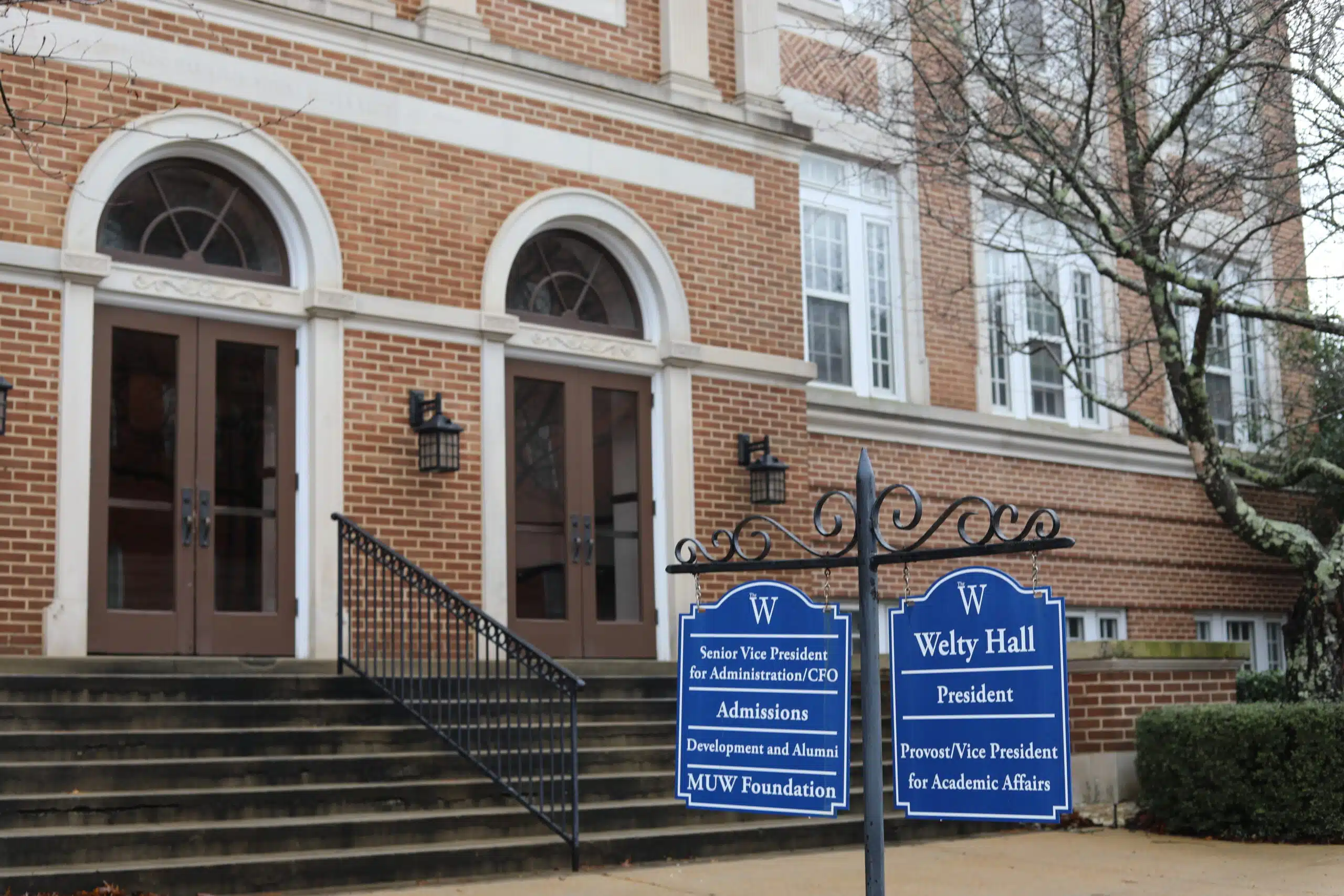
One of the first things Brooking noticed was that MUW needed to do more outreach. The university was buying mailing lists to send letters like the kind Miller got in high school, but not nearly enough names — just 10,000 students when it needed more like 50,000. Brooking fixed that and has expanded MUW’s digital advertising, which he says is the way to reach the introverted, studious high schoolers who’d thrive at MUW.
Showing up at college fairs in parts of Mississippi with a growing population has been a challenge. The recruiting position assigned to the Coast, nearly five hours from Columbus, had been open since September, but only one person applied. Brooking plans to repost it as a remote job.
Even when MUW is present, the name impedes the elevator pitch.
“You only get two or three minutes to talk to a student at a college fair, if they’re even showing interest,” Brooking said. “We have to tell them what we’re not before we can tell them what we are.”
Brooking’s new approach isn’t expected to bear fruit until this fall, Miller said. In the meantime, students can tell the campus is emptier. Laila Wrenn, a member of the student government and a resident assistant, has noticed there are fewer freshmen in the dorms.
A junior on the pre-med track, Wrenn came to MUW for its close-knit campus, but she gets why others don’t.
“It’s just not fitting what they wanted college to be, kind of how they portray college on TV,” she said. “When you’re at the W, it doesn’t fit that picture. It’s not a party school. People commute here. It’s really quiet and it’s down to earth, and I feel like a lot of people aren’t attracted to that.”
MUW does have one powerful tool on its side — cost. At $7,766, it has the second lowest tuition for a public university in Mississippi. (In contrast, a year of tuition at Mississippi State runs $9,400.)
“If you’re gonna quote me on anything about that college,” said Ryan Ahrens, who graduated from MUW in 2021 with a business degree, “it is for sure and without a doubt the bargain of the century.”
Competing for men — literally
Ahrens, a Lowndes County native and transfer from East Mississippi Community College, was the exact kind of student MUW has been desperate to attract. And yet, he ended up there by accident.
“I missed the admissions window for State, and then I said at least the W is still open,” he said.
The university’s name is one reason it has struggled more than other former women-only colleges to attract men, according to a 2009 study commissioned when a past president, Claudia Limbert, sought to change the name. Since 1990, MUW has barely moved the needle on the number of men it admits, from 442 to 532 in 2020.
For his part, Ahrens thought the two-year renaming process moved too quickly. But alumni don’t control the school, he said.
“It’s not our job to have a hand in the pot, it’s our job to make the pot full,” he said. “In order for you to be proud of the university that you graduated from, it still has to be there decades after you leave it.”
But the name is far from the only area of improvement Ahrens sees. He listed several things that, as a conservative, white member of a fraternity, he saw could be improved: The dorms, the outreach and a vibe he described as “a stern ‘what are you doing here’ kind of look.”
“If you’re a man going through the W, you gotta go in with a strong mind and a thick skin cause people are gonna talk crap, like ‘you’re just another W girl,’’ Ahrens said. “Like no man, I’m a man.”
And then there are sports. Changing the name, Ahrens said, is the hardest thing an MUW president has attempted to do since getting into the NCAA last year. Bringing back sports, which the university disbanded in 2003, is part of an effort to attract more students.
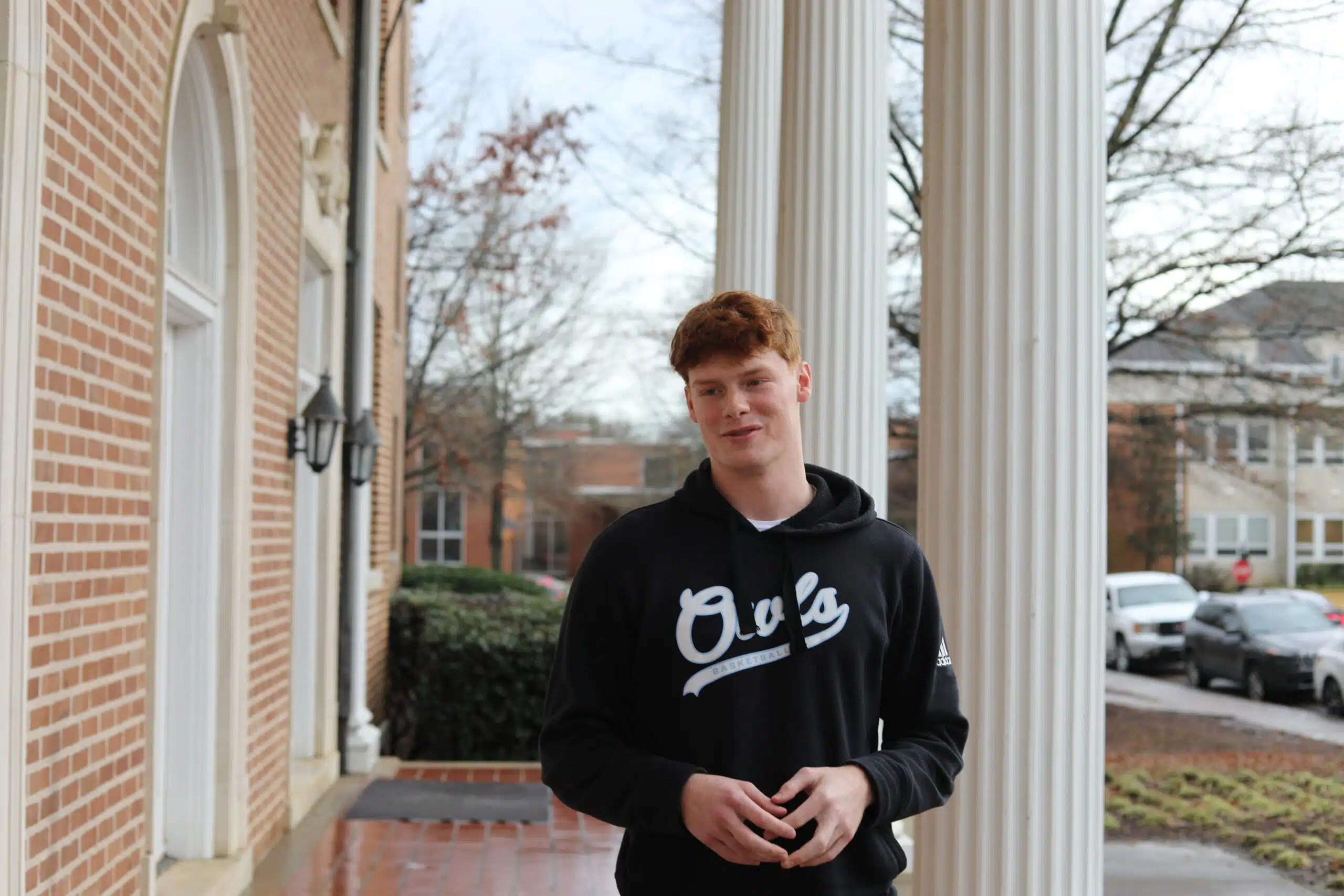
It’s unclear if it’s working yet. Josh Dukes, a sophomore shooting guard from Booneville whose high school basketball team won the state championship, was enticed by the opportunity to help build MUW’s program from the ground up.
But his family of five brothers (and one sister) jokes that Dukes is playing “women’s basketball.” The team has a losing record. The university’s name makes it easier for other players, Dukes said, to “get inside your head.”
Losing its home turf
There is an elephant-sized bulldog in the room.
When Miller attended MUW in the 1980s, it had a complementary relationship to Mississippi State. Male students would come to Columbus to drink and eat out, because Lowndes County was wet and Oktibbeha County was dry. Female students would go to Starkville for the games.
It’s more competitive now.
Today, MSU is roaring, enjoying record enrollments, major success in fundraising and a slew of new construction projects. It is also raking in an increasing share of the number of college students who hail from Lowndes County, making MUW the only regional college in Mississippi at risk of losing its home turf.
In 2022, 450 students went to MUW compared to 432 to MSU, according to IHL data.
MUW is like a tiny planet that may be fated to fall into MSU’s orbit.
“They’ve got more gravitational pull than we do being so close to them,” Brooking said.
IHL classifies MUW as a “regional college,” yet MUW’s leaders know that in many ways, they are outmatched by MSU and EMCC. MUW must own its backyard, Miller said, but it also needs a name that can attract students from across the state and the South, one that gets at the one thing the small campus has: A private-college feel on a state-dollar dime that is accessible to all.
“At Mississippi State or Ole Miss, you might be intimidated … by the people with connections,” Miller said. “Others might say, ‘I couldn’t compete against that.’ But here, we nurture people taking on responsibility and getting to be a leader.”
But is that message connecting with Mississippians?
In downtown Columbus, where the number of local businesses rival Oxford’s Square, Naiya Bell, a 21-year-old community college student who was looking for jobs with her friends, said she had considered MUW’s nursing program.

But Brenda Heard, a landlord dropping off dry-cleaning who lives in Alabama, leases to MUW students but didn’t know if the university admitted men. Roderick Dillard, a firefighter, said his daughters went to MSU for the experience.
“Kids like to get out,” Dillard said.
Naomi Simpson and Angel Viveros students from the academically rigorous Mississippi School for Math and Science, were walking into a local bookstore as they recalled their high school’s recent college fair, which was held in MUW’s gym. Simpson listed off the tables she recalled Mississippi State having: Agriculture, the honors college, education and more.
Then Simpson paused. For a moment, neither student could remember if MUW was there, too. It was, Viveros remembered.
Simpson shrugged. “Maybe I just didn’t go up to them.”
This article first appeared on Mississippi Today and is republished here under a Creative Commons license.
Did you miss our previous article…
https://www.biloxinewsevents.com/?p=327817
Mississippi Today
Mississippi prepares for another execution
The Mississippi Supreme Court has set the execution of a man who kidnapped and murdered a 20-year-old community college student in north Mississippi 30 years ago.
Charles Ray Crawford, 59, is set to be executed Oct. 15 at the Mississippi State Penitentiary at Parchman, after multiple requests by the attorney general’s office.
Eight justices joined the majority opinion to set the execution, concluding that Crawford has exhausted all state and federal legal remedies. Mississippi Supreme Court Justice T. Kenneth Griffis Jr. wrote the Friday opinion. Justice David Sullivan did not participate.
However, Kristy Noble with the Mississippi Office of Capital Post-Conviction Counsel released a statement saying it will file another appeal with the U.S. Supreme Court.
“”Mr. Crawford’s inexperienced trial counsel conceded his guilt to the jury — against Mr.
Crawford’s timely and repeated objections,” Noble said in the statement. “Mr. Crawford told his counsel to pursue a not guilty verdict. Counsel did just the opposite, which is precisely what the U.S. Supreme Court says counsel cannot do,” Noble said in the statement.
“A trial like Mr. Crawford’s – one where counsel concedes guilt over his client’s express wishes – is essentially no trial at all.”
Last fall, Crawford’s attorneys asked the court not to set an execution date because he hadn’t exhausted appeal efforts in federal court to challenge a rape conviction that is not tied to his death sentence. In June, the U.S. Supreme Court declined to take up Crawford’s case.
A similar delay occurred a decade ago, when the AG’s office asked the court to reset Crawford’s execution date, but that was denied because efforts to appeal his unrelated rape conviction were still pending.
After each unsuccessful filing, the attorney general’s office asked the Mississippi Supreme Court to set Crawford’s execution date.
On Friday, the court also denied Crawford’s third petition for post-conviction relief and a request for oral argument. It accepted the state’s motion to dismiss the petition. Seven justices concurred and Justice Leslie King concurred in result only. Again, Justice Sullivan did not participate.
Crawford was convicted and sentenced to death in Lafayette County for the 1993 rape and murder of North Mississippi Community College student Kristy Ray.
Days before he was set to go to trial on separate aggravated assault and rape charges, he kidnapped Ray from her parents’ Tippah County home, leaving ransom notes. Crawford took Ray to an abandoned barn where he stabbed her, and his DNA was found on her, indicating he sexually assaulted her, according to court records.
Crawford told police he had blackouts and only remembered parts of the crime, but not killing Ray. Later he admitted “he must of killed her” and led police to Ray’s body, according to court records.
At his 1994 trial he presented an insanity defense, including that he suffered from psychogenic amnesia – periods of time lapse without memory. Medical experts who provided rebuttal testimony said Crawford didn’t have psychogenic amnesia and didn’t show evidence of bipolar illness.
The last person executed in Mississippi was Richard Jordan in June, previously the state’s oldest and longest serving person on death row.
There are 36 people on death row, according to records from the Mississippi Department of Corrections.
Update 9/15/25: This story has been updated to include a response from the Mississippi Office of Capital Post-Conviction Counsel
This article first appeared on Mississippi Today and is republished here under a Creative Commons Attribution-NoDerivatives 4.0 International License.
The post Mississippi prepares for another execution appeared first on mississippitoday.org
Note: The following A.I. based commentary is not part of the original article, reproduced above, but is offered in the hopes that it will promote greater media literacy and critical thinking, by making any potential bias more visible to the reader –Staff Editor.
Political Bias Rating: Centrist
The article presents a factual and balanced account of the legal proceedings surrounding a scheduled execution in Mississippi. It includes perspectives from both the state’s attorney general’s office and the defense counsel, without using emotionally charged language or advocating for a particular political stance. The focus on legal details and court decisions reflects a neutral, informative approach typical of centrist reporting.
Mississippi Today
Presidents are taking longer to declare major natural disasters. For some, the wait is agonizing
TYLERTOWN — As an ominous storm approached Buddy Anthony’s one-story brick home, he took shelter in his new Ford F-250 pickup parked under a nearby carport.
Seconds later, a tornado tore apart Anthony’s home and damaged the truck while lifting it partly in the air. Anthony emerged unhurt. But he had to replace his vehicle with a used truck that became his home while waiting for President Donald Trump to issue a major disaster declaration so that federal money would be freed for individuals reeling from loss. That took weeks.
“You wake up in the truck and look out the windshield and see nothing. That’s hard. That’s hard to swallow,” Anthony said.
Disaster survivors are having to wait longer to get aid from the federal government, according to a new Associated Press analysis of decades of data. On average, it took less than two weeks for a governor’s request for a presidential disaster declaration to be granted in the 1990s and early 2000s. That rose to about three weeks during the past decade under presidents from both major parties. It’s taking more than a month, on average, during Trump’s current term, the AP found.
The delays mean individuals must wait to receive federal aid for daily living expenses, temporary lodging and home repairs. Delays in disaster declarations also can hamper recovery efforts by local officials uncertain whether they will receive federal reimbursement for cleaning up debris and rebuilding infrastructure. The AP collaborated with Mississippi Today and Mississippi Free Press on the effects of these delays for this report.
“The message that I get in the delay, particularly for the individual assistance, is that the federal government has turned its back on its own people,” said Bob Griffin, dean of the College of Emergency Preparedness, Homeland Security and Cybersecurity at the University at Albany in New York. “It’s a fundamental shift in the position of this country.”
The wait for disaster aid has grown as Trump remakes government
The Federal Emergency Management Agency often consults immediately with communities to coordinate their initial disaster response. But direct payments to individuals, nonprofits and local governments must wait for a major disaster declaration from the president, who first must receive a request from a state, territory or tribe. Major disaster declarations are intended only for the most damaging events that are beyond the resources of states and local governments.
Trump has approved more than two dozen major disaster declarations since taking office in January, with an average wait of almost 34 days after a request. That ranged from a one-day turnaround after July’s deadly flash flooding in Texas to a 67-day wait after a request for aid because of a Michigan ice storm. The average wait is up from a 24-day delay during his first term and is nearly four times as long as the average for former Republican President George H.W. Bush, whose term from 1989-1993 coincided with the implementation of a new federal law setting parameters for disaster determinations.
The delays have grown over time, regardless of the party in power. Former Democratic President Joe Biden, in his last year in office, averaged 26 days to declare major disasters — longer than any year under former Democratic President Barack Obama.

FEMA did not respond to the AP’s questions about what factors are contributing to the trend.
Others familiar with FEMA noted that its process for assessing and documenting natural disasters has become more complex over time. Disasters have also become more frequent and intense because of climate change, which is mostly caused by the burning of fuels such as gas, coal and oil.
The wait for disaster declarations has spiked as Trump’s administration undertakes an ambitious makeover of the federal government that has shed thousands of workers and reexamined the role of FEMA. A recently published letter from current and former FEMA employees warned the cuts could become debilitating if faced with a large-enough disaster. The letter also lamented that the Trump administration has stopped maintaining or removed long-term planning tools focused on extreme weather and disasters.
Shortly after taking office, Trump floated the idea of “getting rid” of FEMA, asserting: “It’s very bureaucratic, and it’s very slow.”
FEMA’s acting chief suggested more recently that states should shoulder more responsibility for disaster recovery, though FEMA thus far has continued to cover three-fourths of the costs of public assistance to local governments, as required under federal law. FEMA pays the full cost of its individual assistance.
Former FEMA Administrator Pete Gaynor, who served during Trump’s first term, said the delay in issuing major disaster declarations likely is related to a renewed focus on making sure the federal government isn’t paying for things state and local governments could handle.
“I think they’re probably giving those requests more scrutiny,” Gaynor said. “And I think it’s probably the right thing to do, because I think the (disaster) declaration process has become the ‘easy button’ for states.”
The Associated Press on Monday received a statement from White House spokeswoman Abigail Jackson in response to a question about why it is taking longer to issue major natural disaster declarations:
“President Trump provides a more thorough review of disaster declaration requests than any Administration has before him. Gone are the days of rubber stamping FEMA recommendations – that’s not a bug, that’s a feature. Under prior Administrations, FEMA’s outsized role created a bloated bureaucracy that disincentivized state investment in their own resilience. President Trump is committed to right-sizing the Federal government while empowering state and local governments by enabling them to better understand, plan for, and ultimately address the needs of their citizens. The Trump Administration has expeditiously provided assistance to disasters while ensuring taxpayer dollars are spent wisely to supplement state actions, not replace them.”

In Mississippi, frustration festered during wait for aid
The tornado that struck Anthony’s home in rural Tylertown on March 15 packed winds up to 140 mph. It was part of a powerful system that wrecked homes, businesses and lives across multiple states.
Mississippi’s governor requested a federal disaster declaration on April 1. Trump granted that request 50 days later, on May 21, while approving aid for both individuals and public entities.
On that same day, Trump also approved eight other major disaster declarations for storms, floods or fires in seven other states. In most cases, more than a month had passed since the request and about two months since the date of those disasters.
If a presidential declaration and federal money had come sooner, Anthony said he wouldn’t have needed to spend weeks sleeping in a truck before he could afford to rent the trailer where he is now living. His house was uninsured, Anthony said, and FEMA eventually gave him $30,000.
In nearby Jayess in Lawrence County, Dana Grimes had insurance but not enough to cover the full value of her damaged home. After the eventual federal declaration, Grimes said FEMA provided about $750 for emergency expenses, but she is now waiting for the agency to determine whether she can receive more.

“We couldn’t figure out why the president took so long to help people in this country,” Grimes said. “I just want to tie up strings and move on. But FEMA — I’m still fooling with FEMA.”
Jonathan Young said he gave up on applying for FEMA aid after the Tylertown tornado killed his 7-year-old son and destroyed their home. The process seemed too difficult, and federal officials wanted paperwork he didn’t have, Young said. He made ends meet by working for those cleaning up from the storm.
“It’s a therapy for me,” Young said, “to pick up the debris that took my son away from me.”
Historically, presidential disaster declarations containing individual assistance have been approved more quickly than those providing assistance only to public entities, according to the AP’s analysis. That remains the case under Trump, though declarations for both types are taking longer.
About half the major disaster declarations approved by Trump this year have included individual assistance.
Some people whose homes are damaged turn to shelters hosted by churches or local nonprofit organizations in the initial chaotic days after a disaster. Others stay with friends or family or go to a hotel, if they can afford it.
But some insist on staying in damaged homes, even if they are unsafe, said Chris Smith, who administered FEMA’s individual assistance division under three presidents from 2015-2022. If homes aren’t repaired properly, mold can grow, compounding the recovery challenges.

That’s why it’s critical for FEMA’s individual assistance to get approved quickly — ideally, within two weeks of a disaster, said Smith, who’s now a disaster consultant for governments and companies.
“You want to keep the people where they are living. You want to ensure those communities are going to continue to be viable and recover,” Smith said. “And the earlier that individual assistance can be delivered … the earlier recovery can start.”
In the periods waiting for declarations, the pressure falls on local officials and volunteers to care for victims and distribute supplies.
In Walthall County, where Tylertown is, insurance agent Les Lampton remembered watching the weather news as the first tornado missed his house by just an eighth of a mile. Lampton, who moonlights as a volunteer firefighter, navigated the collapsed trees in his yard and jumped into action. About 45 minutes later, the second tornado hit just a mile away.
“It was just chaos from there on out,” Lampton said.
Walthall County, with a population of about 14,000, hasn’t had a working tornado siren in about 30 years, Lampton said. He added there isn’t a public safe room in the area, although a lot of residents have ones in their home.
Rural areas with limited resources are hit hard by delays in receiving funds through FEMA’s public assistance program, which, unlike individual assistance, only reimburses local entities after their bills are paid. Long waits can stoke uncertainty and lead cost-conscious local officials to pause or scale-back their recovery efforts.
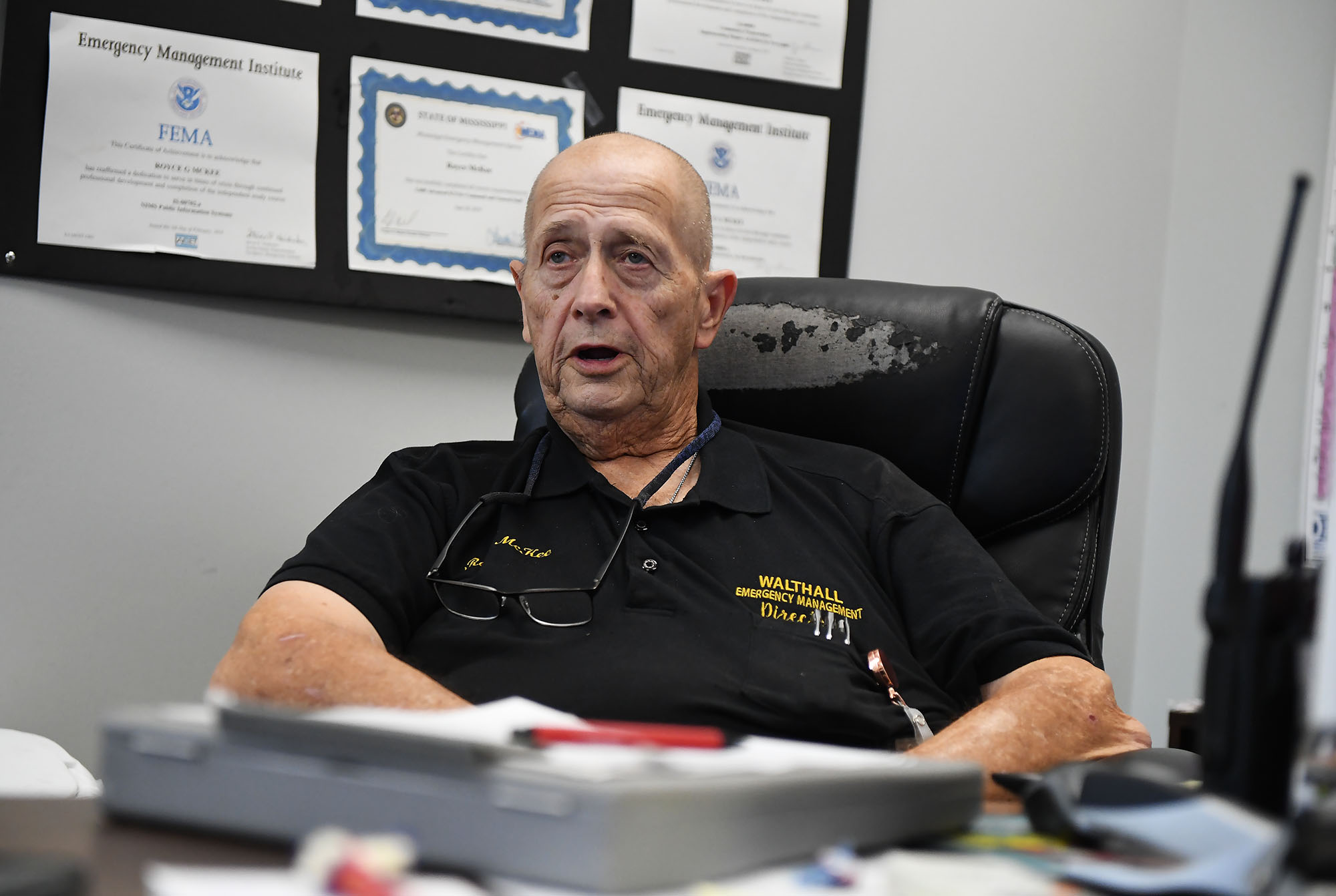
In Walthall County, officials initially spent about $700,000 cleaning up debris, then suspended the cleanup for more than a month because they couldn’t afford to spend more without assurance they would receive federal reimbursement, said county emergency manager Royce McKee. Meanwhile, rubble from splintered trees and shattered homes remained piled along the roadside, creating unsafe obstacles for motorists and habitat for snakes and rodents.
When it received the federal declaration, Walthall County took out a multimillion-dollar loan to pay contractors to resume the cleanup.
“We’re going to pay interest and pay that money back until FEMA pays us,” said Byran Martin, an elected county supervisor. “We’re hopeful that we’ll get some money by the first of the year, but people are telling us that it could be [longer].”
Lampton, who took after his father when he joined the volunteer firefighters 40 years ago, lauded the support of outside groups such as Cajun Navy, Eight Days of Hope, Samaritan’s Purse and others. That’s not to mention the neighbors who brought their own skid steers and power saws to help clear trees and other debris, he added.
“That’s the only thing that got us through this storm, neighbors helping neighbors,” Lampton said. “If we waited on the government, we were going to be in bad shape.”
Lieb reported from Jefferson City, Missouri, and Wildeman from Hartford, Connecticut.
Update 98/25: This story has been updated to include a White House statement released after publication.
This article first appeared on Mississippi Today and is republished here under a Creative Commons Attribution-NoDerivatives 4.0 International License.
The post Presidents are taking longer to declare major natural disasters. For some, the wait is agonizing appeared first on mississippitoday.org
Note: The following A.I. based commentary is not part of the original article, reproduced above, but is offered in the hopes that it will promote greater media literacy and critical thinking, by making any potential bias more visible to the reader –Staff Editor.
Political Bias Rating: Center-Left
This article presents a critical view of the Trump administration’s handling of disaster declarations, highlighting delays and their negative impacts on affected individuals and communities. It emphasizes concerns about government downsizing and reduced federal support, themes often associated with center-left perspectives that favor robust government intervention and social safety nets. However, it also includes statements from Trump administration officials defending their approach, providing some balance. Overall, the tone and framing lean slightly left of center without being overtly partisan.
Mississippi Today
Northeast Mississippi speaker and worm farmer played key role in Coast recovery after Hurricane Katrina
The 20th anniversary of Hurricane Katrina slamming the Mississippi Gulf Coast has come and gone, rightfully garnering considerable media attention.
But still undercovered in the 20th anniversary saga of the storm that made landfall on Aug. 29, 2005, and caused unprecedented destruction is the role that a worm farmer from northeast Mississippi played in helping to revitalize the Coast.
House Speaker Billy McCoy, who died in 2019, was a worm farmer from the Prentiss, not Alcorn County, side of Rienzi — about as far away from the Gulf Coast as one could be in Mississippi.
McCoy grew other crops, but a staple of his operations was worm farming.
Early after the storm, the House speaker made a point of touring the Coast and visiting as many of the House members who lived on the Coast as he could to check on them.
But it was his action in the forum he loved the most — the Mississippi House — that is credited with being key to the Coast’s recovery.
Gov. Haley Barbour had called a special session about a month after the storm to take up multiple issues related to Katrina and the Gulf Coast’s survival and revitalization. The issue that received the most attention was Barbour’s proposal to remove the requirement that the casinos on the Coast be floating in the Mississippi Sound.
Katrina wreaked havoc on the floating casinos, and many operators said they would not rebuild if their casinos had to be in the Gulf waters. That was a crucial issue since the casinos were a major economic engine on the Coast, employing an estimated 30,000 in direct and indirect jobs.
It is difficult to fathom now the controversy surrounding Barbour’s proposal to allow the casinos to locate on land next to the water. Mississippi’s casino industry that was birthed with the early 1990s legislation was still new and controversial.
Various religious groups and others had continued to fight and oppose the casino industry and had made opposition to the expansion of gambling a priority.
Opposition to casinos and expansion of casinos was believed to be especially strong in rural areas, like those found in McCoy’s beloved northeast Mississippi. It was many of those rural areas that were the homes to rural white Democrats — now all but extinct in the Legislature but at the time still a force in the House.
So, voting in favor of casino expansion had the potential of being costly for what was McCoy’s base of power: the rural white Democrats.
Couple that with the fact that the Democratic-controlled House had been at odds with the Republican Barbour on multiple issues ranging from education funding to health care since Barbour was inaugurated in January 2004.
Barbour set records for the number of special sessions called by the governor. Those special sessions often were called to try to force the Democratic-controlled House to pass legislation it killed during the regular session.
The September 2005 special session was Barbour’s fifth of the year. For context, current Gov. Tate Reeves has called four in his nearly six years as governor.
There was little reason to expect McCoy to do Barbour’s bidding and lead the effort in the Legislature to pass his most controversial proposal: expanding casino gambling.
But when Barbour ally Lt. Gov. Amy Tuck, who presided over the Senate, refused to take up the controversial bill, Barbour was forced to turn to McCoy.
The former governor wrote about the circumstances in an essay he penned on the 20th anniversary of Hurricane Katrina for Mississippi Today Ideas.
“The Senate leadership, all Republicans, did not want to go first in passing the onshore casino law,” Barbour wrote. “So, I had to ask Speaker McCoy to allow it to come to the House floor and pass. He realized he should put the Coast and the state’s interests first. He did so, and the bill passed 61-53, with McCoy voting no.
“I will always admire Speaker McCoy, often my nemesis, for his integrity in putting the state first.”
Incidentally, former Rep. Bill Miles of Fulton, also in northeast Mississippi, was tasked by McCoy with counting, not whipping votes, to see if there was enough support in the House to pass the proposal. Not soon before the key vote, Miles said years later, he went to McCoy and told him there were more than enough votes to pass the legislation so he was voting no and broached the idea of the speaker also voting no.
It is likely that McCoy would have voted for the bill if his vote was needed.
Despite his no vote, the Biloxi Sun Herald newspaper ran a large photo of McCoy and hailed the Rienzi worm farmer as a hero for the Mississippi Gulf Coast.
This article first appeared on Mississippi Today and is republished here under a Creative Commons Attribution-NoDerivatives 4.0 International License.
The post Northeast Mississippi speaker and worm farmer played key role in Coast recovery after Hurricane Katrina appeared first on mississippitoday.org
Note: The following A.I. based commentary is not part of the original article, reproduced above, but is offered in the hopes that it will promote greater media literacy and critical thinking, by making any potential bias more visible to the reader –Staff Editor.
Political Bias Rating: Centrist
The article presents a factual and balanced account of the political dynamics surrounding Hurricane Katrina recovery efforts in Mississippi, focusing on bipartisan cooperation between Democratic and Republican leaders. It highlights the complexities of legislative decisions without overtly favoring one party or ideology, reflecting a neutral and informative tone typical of centrist reporting.
-
News from the South - North Carolina News Feed6 days ago
What we know about Charlie Kirk shooting suspect, how he was caught
-
Local News7 days ago
Russian drone incursion in Poland prompts NATO leaders to take stock of bigger threats
-
News from the South - North Carolina News Feed6 days ago
Federal hate crime charge sought in Charlotte stabbing | North Carolina
-
The Center Square7 days ago
Weapon recovered as manhunt continues in Kirk assassination investigation | National
-
Our Mississippi Home5 days ago
Screech Owls – Small but Cute
-
News from the South - Arkansas News Feed6 days ago
NW Arkansas Championship expected to bring money to Rogers
-
News from the South - Alabama News Feed7 days ago
Huntsville Fire & Rescue Holds 9/11 Memorial Service | Sept. 11, 2025 | News 19 at 5 p.m.
-
News from the South - North Carolina News Feed6 days ago
Under pressure, some immigrants are leaving American dreams behind














